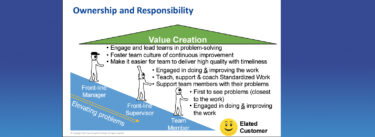People often ask me, “What job guarantees should we be offering as part of implementing kaizen?” How they ask this question depends on whether or not they are working in a union environment.
I’ve often said that people are the only element in business capable of true transformation. For Lean to work at the strategic level, everyone needs to think and act in a new way. So you cannot implement Lean and think about laying people off after every kaizen. The best improvement ideas will always come from the people doing the work (despite what your middle managers might think). If people see others getting laid off as a result of their or others’ suggestions for how to improve the work, the suggestions will stop. If people are cynical about what is being asked of them, they will stop contributing their ideas and energy.
That said, some companies have cost structures based on legacy practices that require a reduction in force to become lean. When this is the case, I think it is best to do this before you begin your lean turnaround. Incentivizing early retirement or other such voluntary reductions is the least harmful way to do this. Remember there will be some benefits to this painful necessity: being suddenly forced to produce the same amount with less people will require many kaizens early on. This might seem a little scary, but it really does help to focus your attention.
Then the upsides will become clearer. As you free up more and more people through kaizen, you will be able to actually avoid layoffs by finding new ways to use people more wisely. You can build on gains by cutting overtime, eliminating all temporary workers, and assigning your best people who have been freed up to your kaizen promotion office. These folks can then work on the next improvement, perhaps the work that you may have outsourced in the past.
Even with all of these buffers, you should always have a caveat in your job guarantee that if the business is threatened, for example in a severe recession, you do have the right to lay people off then. If this needs to happen, just make sure this is clearly separate from any kaizen activity. Never lay off anyone as a result of kaizen.
As for the issue of union versus non-union, I don’t see this as a significant hurdle. Our first lean implementation back in my days as a Danaher Corporation Group was a U.A.W. location—so too was the Wiremold Company. In both cases we were extremely successful. Yes, unions present additional challenges due to contracts with lots of work rules and job classifications. But you just have to work through these things step by step. We cut job classifications from over 50 to about 5. We did a lot of cross-training and worked hand-in-hand on the shopfloor with union associates to improve the work. The key I think is to treat people well, where everyone is part of the team and appreciated for their contributions. If you treat union members differently because they are part of the union, you are asking for trouble.
Finally, let me add one piece of advice about your people. Don’t set wimpy goals! The point is not to avoid conflict, but to challenge everyone to perform to the best of their ability. It is disrespectful for you to think people cannot do great things.





